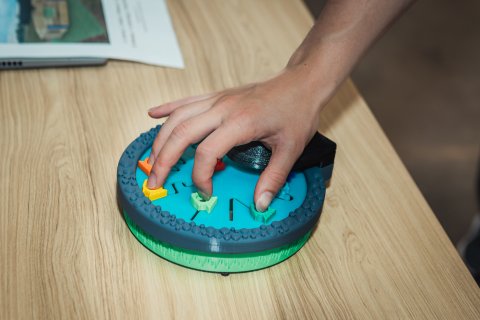Achieve a “Guppy” Hold


Innovative Occupational Therapy Device Developed by Ohio Northern University Students
At Ada Elementary in Ohio, a novel approach to occupational therapy has emerged with the introduction of the “Guppy Grip,” an inventive hand therapy device designed specifically for children. Created by Ohio Northern University (ONU) mechanical engineering students Maria Geiger and Olivia “Liv” Mueller, the Guppy Grip aims to make hand-strengthening exercises both engaging and fun for young patients.
The pair dedicated the academic year to developing this portable device, which is engineered to enhance both flexion and extension muscle strength in a child’s hands. “Sometimes, young children struggling with hand dexterity lack motivation to perform essential hand strengthening exercises,” Geiger noted. “Our goal was to make therapy enjoyable and boost children’s confidence, encouraging their active participation in their recovery process.”
The Guppy Grip took inspiration from a project developed in the previous spring by another ONU engineering team during a Foundations of Design 2 course. Recognizing the potential for improvement, Geiger and Mueller adapted the previous prototype to better cater to a younger audience as part of their course in Engineering Projects for Community Service (EPICS).
In the design process, the duo sought guidance from experts in occupational therapy, including Nichole Dearth from Ada Elementary and Jessica Peters from Great Day Academy. They also consulted Cheyenne (Raker) Townson, an ONU alumna and professional toy designer, who advised them to incorporate an engaging storyline into the device to enhance its appeal as a play tool rather than merely a therapeutic device.
“We chose a pond theme, featuring fish sliders for finger placement and engraved worms and flies along the paths,” explained Geiger. “The base mimics grass, while the lid is textured to resemble stones and rocks.” With eight sliders that offer adjustable resistance, the device challenges users to maneuver their fingers creatively as they guide the fish to their respective bait.
To validate their design, Geiger and Mueller brought a prototype into a classroom setting, where the immediate engagement of the children was a promising sign. “Nearly instantaneously, the kids began interacting with it, which was incredibly gratifying to witness,” stated Geiger.
In addition to developing a solution that addresses an important community need, Geiger and Mueller embrace the learning experience that came with this project. The process provided them with valuable skills in engineering design alongside practical experience in 3D modeling and printing.
“The opportunity to merge art and mathematics into a functional design was particularly exciting for me, as I am passionate about both,” Geiger shared. “I take great pride in what Liv and I have achieved together on this project.”
The Guppy Grip highlights the intersection of creativity and engineering within the field of occupational therapy, emphasizing the potential impact of innovative solutions in enhancing the quality of life for children in need. This endeavor reflects ONU’s commitment to community service and the importance of collaboration between engineering and healthcare fields.





